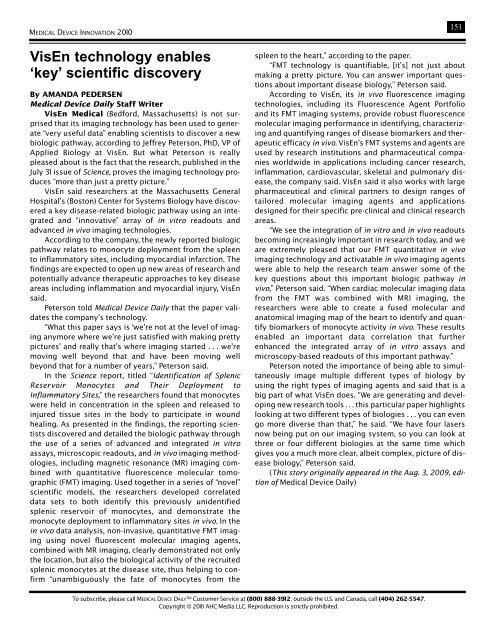MEDICAL DEVICE INNOVATION - Medical Device Daily
MEDICAL DEVICE INNOVATION - Medical Device Daily
MEDICAL DEVICE INNOVATION - Medical Device Daily
Create successful ePaper yourself
Turn your PDF publications into a flip-book with our unique Google optimized e-Paper software.
<strong>MEDICAL</strong> <strong>DEVICE</strong> <strong>INNOVATION</strong> 2010<br />
VisEn technology enables<br />
‘key’ scientific discovery<br />
By AMANDA PEDERSEN<br />
<strong>Medical</strong> <strong>Device</strong> <strong>Daily</strong> Staff Writer<br />
VisEn <strong>Medical</strong> (Bedford, Massachusetts) is not surprised<br />
that its imaging technology has been used to generate<br />
“very useful data” enabling scientists to discover a new<br />
biologic pathway, according to Jeffrey Peterson, PhD, VP of<br />
Applied Biology at VisEn. But what Peterson is really<br />
pleased about is the fact that the research, published in the<br />
July 31 issue of Science, proves the imaging technology produces<br />
“more than just a pretty picture.”<br />
VisEn said researchers at the Massachusetts General<br />
Hospital’s (Boston) Center for Systems Biology have discovered<br />
a key disease-related biologic pathway using an integrated<br />
and “innovative” array of in vitro readouts and<br />
advanced in vivo imaging technologies.<br />
According to the company, the newly reported biologic<br />
pathway relates to monocyte deployment from the spleen<br />
to inflammatory sites, including myocardial infarction. The<br />
findings are expected to open up new areas of research and<br />
potentially advance therapeutic approaches to key disease<br />
areas including inflammation and myocardial injury, VisEn<br />
said.<br />
Peterson told <strong>Medical</strong> <strong>Device</strong> <strong>Daily</strong> that the paper validates<br />
the company’s technology.<br />
“What this paper says is ‘we’re not at the level of imaging<br />
anymore where we’re just satisfied with making pretty<br />
pictures’ and really that’s where imaging started . . . we’re<br />
moving well beyond that and have been moving well<br />
beyond that for a number of years,” Peterson said.<br />
In the Science report, titled “Identification of Splenic<br />
Reservoir Monocytes and Their Deployment to<br />
Inflammatory Sites,” the researchers found that monocytes<br />
were held in concentration in the spleen and released to<br />
injured tissue sites in the body to participate in wound<br />
healing. As presented in the findings, the reporting scientists<br />
discovered and detailed the biologic pathway through<br />
the use of a series of advanced and integrated in vitro<br />
assays, microscopic readouts, and in vivo imaging methodologies,<br />
including magnetic resonance (MR) imaging combined<br />
with quantitative fluorescence molecular tomographic<br />
(FMT) imaging. Used together in a series of “novel”<br />
scientific models, the researchers developed correlated<br />
data sets to both identify this previously unidentified<br />
splenic reservoir of monocytes, and demonstrate the<br />
monocyte deployment to inflammatory sites in vivo. In the<br />
in vivo data analysis, non-invasive, quantitative FMT imaging<br />
using novel fluorescent molecular imaging agents,<br />
combined with MR imaging, clearly demonstrated not only<br />
the location, but also the biological activity of the recruited<br />
splenic monocytes at the disease site, thus helping to confirm<br />
“unambiguously the fate of monocytes from the<br />
151<br />
spleen to the heart,” according to the paper.<br />
“FMT technology is quantifiable, [it’s] not just about<br />
making a pretty picture. You can answer important questions<br />
about important disease biology,” Peterson said.<br />
According to VisEn, its in vivo fluorescence imaging<br />
technologies, including its Fluorescence Agent Portfolio<br />
and its FMT imaging systems, provide robust fluorescence<br />
molecular imaging performance in identifying, characterizing<br />
and quantifying ranges of disease biomarkers and therapeutic<br />
efficacy in vivo. VisEn’s FMT systems and agents are<br />
used by research institutions and pharmaceutical companies<br />
worldwide in applications including cancer research,<br />
inflammation, cardiovascular, skeletal and pulmonary disease,<br />
the company said. VisEn said it also works with large<br />
pharmaceutical and clinical partners to design ranges of<br />
tailored molecular imaging agents and applications<br />
designed for their specific pre-clinical and clinical research<br />
areas.<br />
“We see the integration of in vitro and in vivo readouts<br />
becoming increasingly important in research today, and we<br />
are extremely pleased that our FMT quantitative in vivo<br />
imaging technology and activatable in vivo imaging agents<br />
were able to help the research team answer some of the<br />
key questions about this important biologic pathway in<br />
vivo,” Peterson said. “When cardiac molecular imaging data<br />
from the FMT was combined with MRI imaging, the<br />
researchers were able to create a fused molecular and<br />
anatomical imaging map of the heart to identify and quantify<br />
biomarkers of monocyte activity in vivo. These results<br />
enabled an important data correlation that further<br />
enhanced the integrated array of in vitro assays and<br />
microscopy-based readouts of this important pathway.”<br />
Peterson noted the importance of being able to simultaneously<br />
image multiple different types of biology by<br />
using the right types of imaging agents and said that is a<br />
big part of what VisEn does. “We are generating and developing<br />
new research tools . . . this particular paper highlights<br />
looking at two different types of biologies . . . you can even<br />
go more diverse than that,” he said. “We have four lasers<br />
now being put on our imaging system, so you can look at<br />
three or four different biologies at the same time which<br />
gives you a much more clear, albeit complex, picture of disease<br />
biology,” Peterson said.<br />
(This story originally appeared in the Aug. 3, 2009, edition<br />
of <strong>Medical</strong> <strong>Device</strong> <strong>Daily</strong>)<br />
To subscribe, please call <strong>MEDICAL</strong> <strong>DEVICE</strong> DAILY Customer Service at (800) 888-3912; outside the U.S. and Canada, call (404) 262-5547.<br />
Copyright © 2010 AHC Media LLC. Reproduction is strictly prohibited.
















